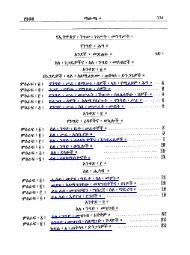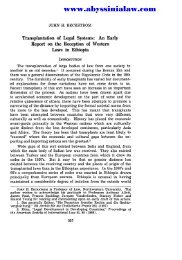Create successful ePaper yourself
Turn your PDF publications into a flip-book with our unique Google optimized e-Paper software.
1967] LEGAL www.abyssinialaw.com<br />
SYSTEMS<br />
tomary law as such has no place in the legal system. In most other<br />
sub-Saharan countries there are two sources of law, the formal law<br />
and customary law, each applicable in certain circumstances. This<br />
is not so in Ethiopia and it is therefore important to analyze why<br />
Ethiopia has taken such a different position.<br />
In the first place, unlike the other African countries there had never<br />
been a body of customary law separate and distinct from the formal<br />
law. Nor were there customary courts as such, though frequently<br />
disputes were brought before the traditional authorities. What we call<br />
customary law was recognized as a source of law and could form the<br />
basis of judicial decision. But so could the Fetha Negast and other<br />
"rules." And as was seen, in the earlier stages of the administration<br />
of justice, the concept of legal rules as binding norms did not exist.<br />
In more recent times when the courts considered custom, it was one<br />
of a number of sources that could be drawn upon along with foreign<br />
precedents and principles of "equity.' 17 - Customary law was not a<br />
separate body of law to be applied in certain cases or to certain persons.<br />
Thus, customary law did not develop as a defined body of law. The<br />
customary law that existed was very uncertain, and varied considerably<br />
from place to place, group to group, and even from time to time. 70<br />
Moreover, as Professor Krzeczunowicz has pointed out, 77 Ethiopia<br />
cannot be considered in the purely African customary context. The<br />
Ethiopian tradition included Western, Judeo-Christian, and Greco-<br />
Roman concepts. In the hierarchy of laws custom was considered inferior<br />
to the Fetha Negast. Although the Fetha Negast was not consistently<br />
followed,' 7 it was considered a compilation of great dignity<br />
and wisdom, a status that customary law did not have. 79<br />
In light of these factors, to have a separate body of customary law<br />
as distinct from the formal law would be to introduce a new concept<br />
into Ethiopia. There had been no customary courts nor a separate<br />
system of customary law, as in other African countries. It was not the<br />
policy of the government that one set of laws could be applicable to<br />
one person and another set of laws applicable to another. s0 Where<br />
laws had been promulgated by the central government, e.g., the <strong>Law</strong><br />
" See Krzeczunowicz, supra note 36, at 58.<br />
3 76David, supra note 21, at 489. In Eritrea some efforts at unifying the customary<br />
law were made, and some of the customary law was recorded. Krzeczunowicz,<br />
supra note 36, at 58.<br />
'1 7 Krzeczunowicz, supra note 66, at 173.<br />
' 7 SKrzeczunowicz, supra note 36, at 58.<br />
179 See David, supra note 21, at 499.<br />
180 Except as regards the Moslem population at present, for the reasons to be<br />
discussed subsequently.





